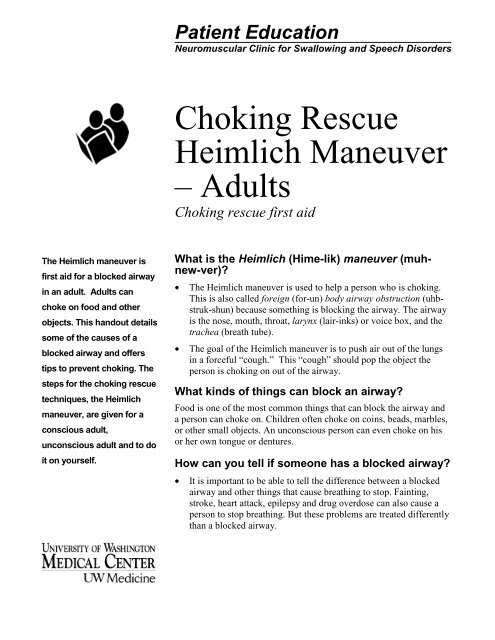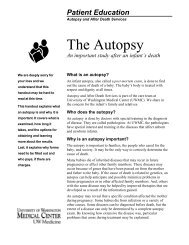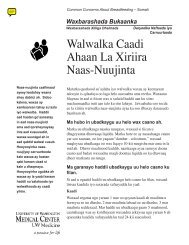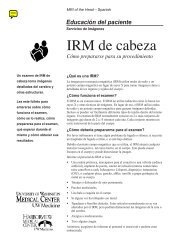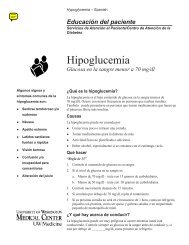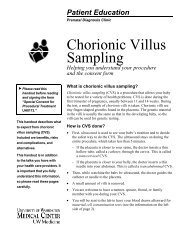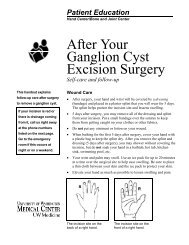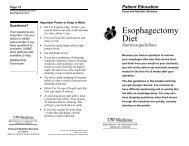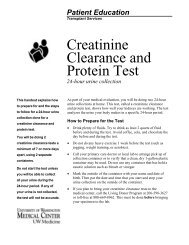Choking Rescue Heimlich Maneuver Adults8_01 - UWMC Health ...
Choking Rescue Heimlich Maneuver Adults8_01 - UWMC Health ...
Choking Rescue Heimlich Maneuver Adults8_01 - UWMC Health ...
- No tags were found...
You also want an ePaper? Increase the reach of your titles
YUMPU automatically turns print PDFs into web optimized ePapers that Google loves.
Page 2Neuromuscular Clinic for Swallowing and Speech Disorders<strong>Choking</strong> <strong>Rescue</strong> <strong>Heimlich</strong> <strong>Maneuver</strong> – Adults• A conscious (awake) person who has only a partly blocked airwaymay at first be able to cough and breathe on his own. The personmay wheeze (high pitched squeaky sound) as he tries to breathe.He may be able to cough up on his own the object stuck in hisairway.• If the airway becomes completely blocked, the person’s cough willget weaker. He will not be able to talk or breathe at all and maystart to turn blue. The person may grab his own throat with histhumb and fingers. This means the person is trying to say, “Icannot breathe!”Is there anything you can do to prevent an airwayobstruction?Many times an airway obstruction happens when a person is eatingand chokes on a piece of food. Here are some things you can do toprevent this from happening.• Cut food into small pieces.• Chew your food slowly and well, especially if you wear dentures.• Try not to talk and laugh while chewing and swallowing.• Do not walk, run, or play with food in your mouth.• Some foods that seem harmless are easy to choke on. Some foodslike peanuts, peanut butter, popcorn, and other foods must bechewed very well before being swallowed. Do not eat these kindsof foods if you cannot chew well.How do you do the <strong>Heimlich</strong> maneuver on anotherperson?The first thing you should do when you find someone choking is tofind out if the person is OK. Do this by asking loudly, “Are you OK?Can you breathe?” If the person says yes, do nothing. Do not do the<strong>Heimlich</strong> maneuver if the person can breathe and talk. This couldmake it worse. If the person nods “NO,” do the <strong>Heimlich</strong> maneuverusing the steps on the next page.
Page 3Neuromuscular Clinic for Swallowing and Speech Disorders<strong>Choking</strong> <strong>Rescue</strong> <strong>Heimlich</strong> <strong>Maneuver</strong> – Adults• If the person is standing or sitting, stand behind the person andwrap your arms around his waist.1. Make a fist with one hand.2. Place the thumb side of your fist against the middle of theperson’s abdomen (belly) just above the navel (belly button).Do not put your fist on the xiphoid (zi-foid) process or ribs.The xiphoid process is the small bone in the center of the chestwhere the ribs meet. It is very easy to break this bone and hurtthe organs inside the abdomen and chest.3. Put your other hand over your fist. Press your fist into theperson’s abdomen with a quick upward thrust.4. Continue to repeat the thrusts until the object comes out of theairway or the person becomes unconscious.• If the person is unconscious, lay him down flat on the floor on hisback.1. Kneel over the person with one knee beside each thigh.2. Put the heel of one hand against the middle of the person’sabdomen just above the navel. Make sure your hand is belowthe xiphoid process.3. Put your second hand directly on top of the first. Press into theperson’s abdomen with a quick upward thrust. Several thrustsmay be needed to clear the airway.4. Check the person’s mouth to see if the object has popped out.This should not be done if the person is having a seizure(convulsion).5. Open the person’s mouth by holding the tongue and lower jawbetween your thumb and fingers. Lift the jaw up. This will pullthe tongue away from the back of the throat so you can see intothe throat.6. Put your first finger on your other hand down along the insideof the person’s cheek. Move your finger deeply into the throatto the bottom of the tongue. Use a hooking action to loosen theobject and pull it out of the throat into the mouth. Then take theobject out of the mouth.7. If the object has not come out, repeat the thrusts. Continuedoing abdominal thrusts until the object comes out of theairway.8. Once the object comes out, check to see if the person hasstarted to breathe on his own. If the person is breathing on hisown, turn him on his side. Turn him so that his head, shoulders,Belly<strong>Heimlich</strong> maneuver<strong>Heimlich</strong> maneuver on anunconscious person
Page 4Neuromuscular Clinic for Swallowing and Speech Disorders<strong>Choking</strong> <strong>Rescue</strong> <strong>Heimlich</strong> <strong>Maneuver</strong> – AdultsQuestions?Neuromuscular Clinicfor Swallowing andSpeech Disorders:206-598-4022Your questions areimportant. Call yourdoctor or health careprovider if you havequestions or concerns.<strong>UWMC</strong> Clinic staff arealso available to help.Other clinics that canprovide information are:Rehabilitation Medicine/Muscular DystrophyClinic:206-598-4295Pulmonary MedicineClinic:206-598-4615______________________________________________________chest, and abdomen (belly) move together. Do not move theperson if he has injuries to his head, neck, or back. Watch theperson closely.9. If the person does not start breathing on his own, start CPR,and call 9-1-1.How do you do the <strong>Heimlich</strong> maneuver onyourself?Follow these steps:1. Make a fist with one hand.2. Place the thumb side of your fist againstthe middle of your abdomen (belly) justabove your navel (belly button). Do not putyour fist on your xiphoid (zi-foid) processor ribs.3. Put your other hand over your fist. Pressyour fist into your abdomen with a quickupward thrust. Continue to repeat thethrusts until the object comes out of yourairway.<strong>Heimlich</strong> maneuveron yourself4. If this method is not working, press your upper abdomen quicklyover any hard surface. The back of a chair, side of a table, or porchrailing works well. Several thrusts may be needed to clear yourairway.If you want to learn more about the <strong>Heimlich</strong> maneuver or CPR,you can take a class and become certified. Check your localcommunity for classes.__________________Neuromuscular Clinic forSwallowing and SpeechDisordersBox 3561611959 NE Pacific St. Seattle, WA 98195206-598-4022© University of Washington Medical Center08/20<strong>01</strong>Reprints: <strong>Health</strong> Online


